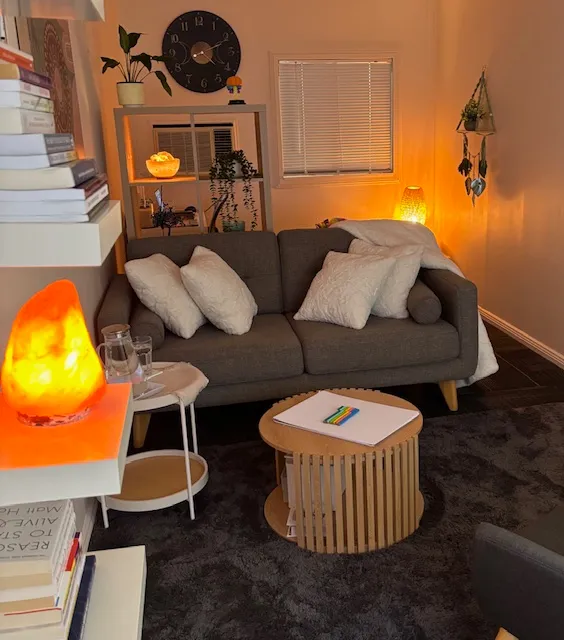Phase 2 Brainspotting Practitioner
Brainspotting is a powerful, focused therapy designed to help you access and process trauma, emotional pain, and stuck experiences at a deep, brain-body level. Developed by Dr David Grand, Brainspotting is based on the understanding that where you look affects how you feel, with certain eye positions helping to locate, access, and release unresolved material held within the brain and nervous system.
This approach is particularly helpful when talking about an issue feels overwhelming, or when you sense that traditional talk therapy alone isn’t reaching the core of what’s going on. Brainspotting works directly with the subcortical brain, the areas below conscious thinking where emotional and procedural memory is stored, making it possible to process experiences that may not be fully accessible through words.
How Does Brainspotting Work?
During Brainspotting, we use eye position as a gateway to connect with areas in the brain where trauma, stress, or emotional overwhelm may be held. By identifying a specific “brainspot”, an eye gaze point that correlates with the felt sense of the issue, we allow the body and brain to process these experiences organically, without needing to retell or re-analyse the story.
The process often involves using a pointer or allowing your gaze to rest naturally at the identified spot, while remaining attuned to the sensations, thoughts, emotions, or images that arise. This creates the conditions for your system to process at its own pace, in its own way, safely guided and supported within the therapeutic relationship.
Brainspotting is based on the belief that the body and brain know how to heal when given the right conditions. By slowing down and attuning to these deeper layers, your system can begin to release what has been stuck, leading to greater ease, clarity, and integration.
What to Expect During a Brainspotting Session
Every Brainspotting session is tailored to your unique needs and comfort levels. Sessions are conducted in a calm, supportive environment where your nervous system is prioritised. There is no pressure to speak or explain everything you are feeling, instead, we pay attention to what is happening in the body and mind in the present moment.
What you can expect:
- A collaborative process where we identify an issue or area of focus (this can be specific or vague, both are welcome).
- Use of either a pointer or free gaze to find the eye position that resonates with the emotional or physical experience you wish to work with.
- An invitation to stay with the gaze point while noticing any sensations, emotions, movements, or memories that arise.
- A therapist who remains fully attuned, offering presence, safety, and support throughout the process.
- Optional use of bilateral music (alternating sound from ear to ear), which can deepen regulation and access.
The experience of Brainspotting can vary from subtle to intense, depending on what your system is ready to process. Sessions may include long periods of silence or emotional release, and you are always in control of the pacing. The focus is on following your body's lead, not pushing into discomfort.
Working Subcortically: Why This Matters
One of the key reasons Brainspotting is so effective is its focus on working subcortically, with the deeper, instinctual parts of the brain such as the limbic system and brainstem. These areas are responsible for regulating emotions, survival responses, procedural memory, and sensory processing. They are also the parts of the brain most affected by trauma.
Traumatic experiences, especially those that occur early in life or without the opportunity for resolution, are often stored in these subcortical regions. Because these areas operate outside of conscious thought, simply "talking about it" may not fully reach or resolve the underlying dysregulation.
By working subcortically, Brainspotting allows for:
- Access to non-verbal memory and body-held trauma.
- Processing beneath cognitive defences, without needing to explain or rationalise.
- Releasing procedural patterns like chronic tension, hypervigilance, freeze responses, or emotional flooding.
- Engaging the body’s natural healing mechanisms, supporting integration between the brain, body, and nervous system.
This makes Brainspotting especially useful for trauma, anxiety, grief, chronic stress, performance blocks, and situations where traditional talk therapy feels limited.
A Gentle Yet Deep Approach
Brainspotting respects your system’s pace and readiness. It is not about forcing catharsis but about creating space for your brain and body to do what they know how to do, heal. Whether you’re working with significant trauma or seeking to shift patterns that no longer serve you, Brainspotting offers a profound and effective pathway toward resolution, balance, and embodied well-being.
Schedule an Appointment
It would be my privilege to walk alongside you on your journey to a more fulfilling life. I offer a free 15-minute phone or video consultation to ensure I am the right fit for your needs.
Book Appointment




